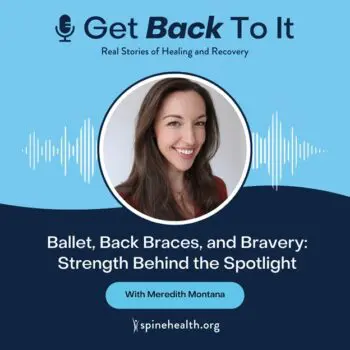For patients with severe spinal deformities, deciding to undergo surgery can be daunting. Many worry about the risks, recovery process, and whether future advancements could provide even better outcomes.
Peggy was no different.
She had endured years of discomfort, declining mobility, and an increasing reliance on others for daily activities. After much deliberation and efforts to “out-work” her condition, Peggy made the life-changing decision to move forward with spinal reconstruction under the care of Dr. Larry Lenke, a specialist in spinal deformity and a professor of orthopedic surgery at Columbia University in New York City.
Her journey showcases her resilience to triumph over her scoliosis both before and after surgery. Ten years after the surgery, she reunites with Dr. Lenke to reflect upon her victory.
Peggy’s Struggles Before Surgery
Peggy first discovered she had thoracic scoliosis as a teenager. At the time, she was told to “just watch it,” as many cases don’t progress to a severe stage. For years, she lived her life without significant issues, adapting to the minor asymmetry in her posture.
But at age 27, a pivotal moment changed everything.
While going about her daily routine, Peggy suddenly felt a sharp, jarring pain in her mid-back that caused her to pass out. This pain was caused by progressive worsening of her scoliosis.
In the years that followed, Peggy began noticing more pronounced changes. She would experience flare-ups of pain that became more and more common. Family and friends even noticed that she had shrunk slightly. Despite these symptoms, Peggy was determined to fight her condition off through exercise and conservative treatment.
Dr. Lenke comments that “…a lot of patients can actually outwork their scoliosis if it’s mild or moderate and minimally progressive,”.
However, as her pain increased and her spine continued to deteriorate, Peggy knew she had to consider surgery. A friend had recommended she see Dr. Lenke. At the time, Peggy was incredibly hesitant to pursue surgery and, therefore, declined it. Dr. Lenke parted with her, saying “You will know when you’re ready,”. She returned to Dr. Lenke nine months later when she herniated a vertebral disc which made her unable to stand or walk.
The Surgery and the Road to Recovery
Just before surgery, Peggy had a 75 degree curve in her spine with arthritis forming in certain parts of the curve. She underwent a posterior-based total spine reconstruction from T3 to the sacrum and pelvis with pedicle screws and rods used to nearly fully correct the scoliosis deformity. She also had two cages placed from the back into the front of the spine with bone graft placed inside at the lowest two levels of the spine to help stabilize and enhance the fusion at those segments sitting at the base of the deformity correction above.
Peggy knew the first days after surgery would be challenging. The initial 48 hours were tough, as expected, but with the support of her surgical team, physical and occupational therapists, her family, and her friends, she made steady progress. She only stayed in the hospital for four nights. Peggy attributes this feat to her very active lifestyle she upheld all the way until surgery. Dr. Lenke comments that “Patients have to put in a lot of effort before and after surgery…. The surgeon can do their part and the patient has to do their part… It’s really got to be a partnership,”.
When Peggy returned home, her goal was to see how far she could walk down her long driveway. Day by day, she was able to get farther than she did before.
A New Lease on Life and Why Now Is the Right Time
Now, 10 years after her surgery, Peggy reflects on her journey with immense gratitude. She stands taller, walks farther, and no longer fears that her condition will continue to deteriorate. She is able to return to her beloved hobby of skiing and can keep up with her growing grandchildren.
Peggy shares the words of wisdom she shared with another patient she mentored who was going through a similar situation: “I wish I would have done my surgery a year earlier,”. While she was hesitant for many reasons, she encourages people with similar conditions to not be afraid of surgery.
Dr. Lenke offers that today’s medical advancements can give patients confidence they are making the right choice at the right moment.
For example, in the past, spinal rods had to be manually bent during the operation to fit a patient’s unique anatomy—a process that introduced variability and required additional surgical time. Today, customized rods are pre-designed using advanced engineering techniques weeks before surgery.
Additionally, real-time imaging and robotic assistance help surgeons navigate complex procedures with enhanced accuracy, reducing complications and improving recovery times. These advancements can give scoliosis patients the confidence that they are making the right choice at the right moment.
Peggy’s story is a testament to the power of modern spinal surgery and the resilience of those who undergo it. If you or a loved one are struggling with a spinal condition, remember that waiting isn’t always the best option. With expert guidance and the latest medical advancements, life-changing results are possible today.



